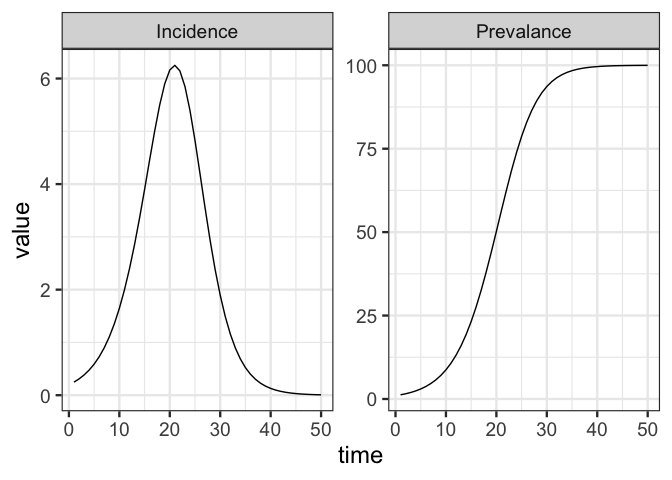
macpan2 is a software platform for building and calibrating compartmental models of infectious disease. It supports flexible model specification and fast parameter calibration, making it easier for modellers to respond to emerging public health threats. Developed through collaboration with the Public Health Agency of Canada (PHAC), macpan2 is being used to support responses to diseases such as mpox (Milwid et al. 2023), measles (PHAC 2024, interactive measles model), and COVID-19 (Simmons et al. 2025; Miranda et al. 2025), and internal work on pandemic preparedness. It has been used for a retrospective analysis of COVID-19 in Newfoundland (Anokye et al. 2025).
The precursor to macpan2 was McMasterPandemic, which was developed to provide forecasts and insights to Canadian public health agencies throughout the COVID-19 pandemic (Public Health Agency of Canada Modelling Group 2020–2022). Much was learned about developing general purpose compartmental modelling software during this experience, but the pressure to deliver regular forecasts made it difficult to focus on the software itself. The goal of this macpan2 project is to re-imagine McMasterPandemic, building it from the ground up with architectural and technological decisions that address the many lessons that we learned from COVID-19 about software.
Documentation
- Package website
- Package reference and function documentation
- Quick-start guide
- Articles describing the package
- Example starter models
- Frequently asked questions
-
TMBengine [specification document] - Project history and trajectory [slides]
- Instructional videos
- Workshop notes
-
Publications and reports [using
macpan2andMcMasterPandemic] -
Visual
macpan2model builder [proof of concept]
Installation
Here is the recommended way to install macpan2 (from within an R session):
install.packages('macpan2'
, repos = c(
'https://canmod.r-universe.dev'
, 'https://cloud.r-project.org'
)
)To get the latest development version of macpan2, or if the above command fails for some reason, try:
remotes::install_github("canmod/macpan2")This command requires the remotes package and assumes that your R environment is set up to build packages that include compiled C++ code (e.g. see details for Windows or MacOS [you probably only need Xcode from this page]).
Many macpan2 workflows also use these four popular packages:
install.packages(c("dplyr", "ggplot2", "tidyr", "broom.mixed"))The Rgraphviz package is useful for plotting flow diagrams of models (see ?dot_layout). To install it:
if (!require("BiocManager", quietly = TRUE))
install.packages("BiocManager")
BiocManager::install("Rgraphviz")Reproducibility
The r-universe, which we use to distribute macpan2, suggests two approaches for projects in production that need to keep track of specific versions of macpan2: snapshots or renv.
To take the first approach, snapshots of macpan2 (and its dependency oor) can be obtained using the following download link.
Please see this documentation for instructions on customizing this download link.
The benefit of the first approach is that it doesn’t require users to be able to compile C++ code, whereas the second does. The benefit of the second approach is that it can be used to manage dependencies on all packages in your workflows. It might be possible to combine the two approaches to get the best of both worlds, but this isn’t tested.
Hello World
The following code specifies an SI model, which is the simplest model of epidemiological transmission.
library(macpan2)
si = mp_tmb_model_spec(
before = S ~ 1 - I
, during = mp_per_capita_flow(
from = "S" ## compartment from which individuals flow
, to = "I" ## compartment to which individuals flow
, rate = "beta * I" ## expression giving _per-capita_ flow rate
, flow_name = "infection" ## name for _absolute_ flow rate = beta * I * S
)
, default = list(I = 0.01, beta = 0.2)
)
print(si)## ---------------------
## Default values:
## quantity value
## I 0.01
## beta 0.20
## ---------------------
##
## ---------------------
## Before the simulation loop (t = 0):
## ---------------------
## 1: S ~ 1 - I
##
## ---------------------
## At every iteration of the simulation loop (t = 1 to T):
## ---------------------
## 1: mp_per_capita_flow(from = "S", to = "I", rate = "beta * I", flow_name = "infection")See this article for more example models with documentation.
Simulating from this model requires choosing the number of time-steps to run and the model outputs to generate. Syntax for simulating macpan2 models is designed to combine with standard data prep and plotting tools in R, as we demonstrate with the following code.
library(ggplot2)
library(dplyr)
(si
|> mp_simulator(time_steps = 50, outputs = c("I", "infection"))
|> mp_trajectory()
|> mutate(quantity = case_match(matrix
, "I" ~ "Prevalence"
, "infection" ~ "Incidence"
))
|> ggplot()
+ geom_line(aes(time, value))
+ facet_wrap(~ quantity, scales = "free")
+ theme_bw()
)
Workshops
We have delivered several macpan2 workshops. Here are the current workshop notes.
| Organization | Date |
|---|---|
| Public Health Agency of Canada | 2025-03-20 |
| Memorial University | 2024-11-07 |
| Simon Fraser University | 2024-13-05 |
| Vancouver Machine Learning Group (VanML) | 2024-02-22 |
| Canadian Network for Modelling Infectious Diseases (CANMOD) | 2023-11-14 |
On June 16-27, 2025, the International Clinics on Infectious Disease Dynamics and Data (ICI3D) Program included labs using macpan2 to specify simple compartmental models and simulate from them and specify an HIV model and fit it to data.
Product Management
The project board tracks the details of bugs, tasks, and feature development.